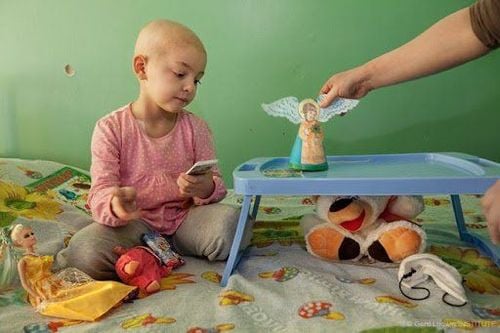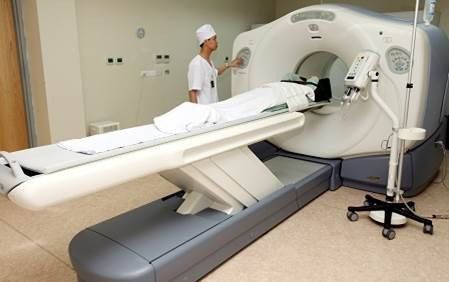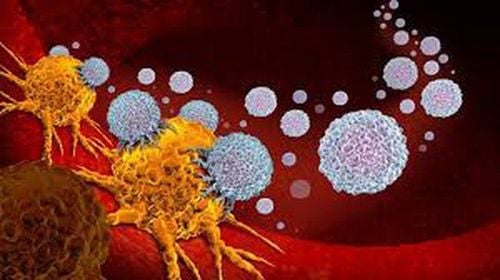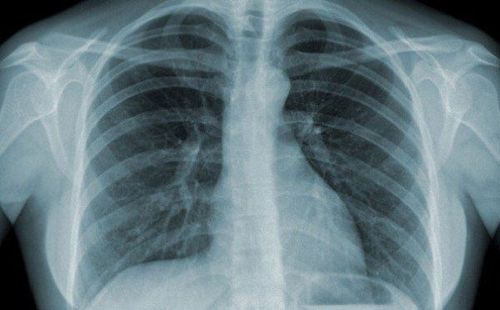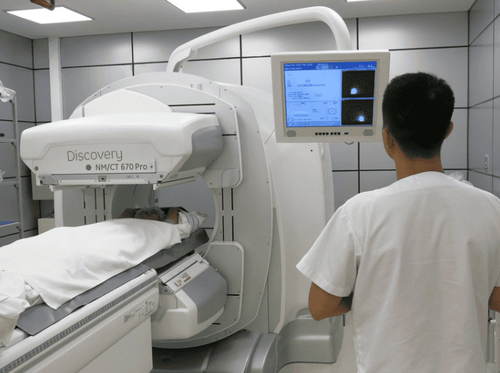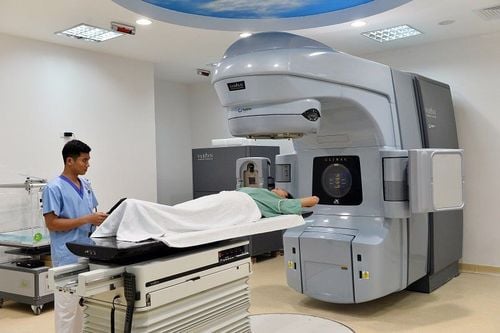This is an automatically translated article.
Radiation sickness, also known as acute radiation syndrome or radiation poisoning, is damage to the body caused by receiving large amounts of radioactive material in a short period of time (acute). The amount of radiation that the body absorbs will determine the extent of damage to the body.1. Symptoms of acute radiation sickness
The severity of the signs and symptoms of acute radiation sickness depends on the amount of radiation the body has absorbed. How much is absorbed depends on the intensity of the radiation energy, the duration of exposure, and the distance between the body and the radioactive source.Signs and symptoms are also affected by the part of the body exposed, such as all or part of the body. The severity of radiation sickness also depends on how sensitive the affected tissues are, for example, the digestive system and bone marrow are very sensitive to radiation.
Initial signs and symptoms The initial signs and symptoms of radiculopathy are usually nausea and vomiting. The length of time when symptoms first appear to when exposure begins is one of the factors that determine how much radiation the body has absorbed.
If the body has had mild exposure, it can take several hours to several weeks for signs and symptoms to begin. But with severe exposure, signs and symptoms can begin minutes to days after exposure.
Symptoms may include:
Nausea and vomiting Diarrhea Headache Fever Dizziness and disorientation Muscle weakness and fatigue Hair loss Vomiting blood and passing out bleeding Infection Low blood pressure.

Triệu chứng ban đầu của bệnh phóng xạ có thể là nôn và buồn nôn
2.Causes of acute radiation sickness
Radiation is energy released from atoms in the form of waves or small particles of matter. Radiation sickness is caused by exposure to high amounts of radiation, such as radiation from a nuclear plant explosion.Possible sources of high dose radiation:
Nuclear plant accident Nuclear plant attack Portable radioactive device exploded During nuclear weapons tests. Radiation sickness occurs when high-energy radiation damages or destroys cells in the body. The areas of the body that are most vulnerable to high-energy radiation are the cells in the lining of the intestines, including the stomach, and the blood cell-producing cells of the bone marrow.
3.Complications of acute radiation sickness
Having radiation sickness can cause short- and long-term mental health problems, such as grief, fear and anxiety about:Just experienced a nuclear explosion Funeral of friends or family that die from a nuclear explosion Think about the illnesses caused by a nuclear explosion and have the potential to be fatal Worry about the cancer risk from radiation exposure.
4. Prevention

Nếu chuẩn bị di tản hãy mang theo thuốc đang điều trị
If you are advised to stay where you are, whether you are at home or work or elsewhere, do the following:
Close and lock all doors and windows Turn off fans, air conditioning and heating appliances bring in outside air Bring pets indoors Move to the basement Follow the news Regularly Stay at least 24 hours. If advised to evacuate, follow instructions provided by local authorities. Try to stay calm and move quickly, in addition, bring essentials such as:
Flashlights First aid kit First-aid kit Medical treatment Prepared foods, such as canned food and bottled water Manual Can Opener Cash and Credit Cards Clothing.
5. Diagnosis of acute radiation sickness
When a person has been exposed or uncertainly exposed to a high dose of radiation by accident or attack, a number of steps are taken by healthcare professionals to determine the dose of radiation the person has absorbed. This information is essential to determine the severity, treatment, and prognosis of a patient's survival. Important information for determining absorbed dose includes:Exposure range: Details of the distance from the radioactive source and the duration of exposure can help provide a rough estimate of the severity of the radiation sickness. Radiation Vomiting and other symptoms: The time interval between the onset of radiation exposure and the onset of vomiting is a fairly accurate screening factor for estimating absorbed radiation dose. The shorter the time before the onset of this sign, the higher the radiation dose. The severity and duration of other signs and symptoms can also help healthcare providers determine absorbed doses Blood tests: Blood tests that are repeated frequently over several days allow the healthcare provider to look for disease-fighting white blood cells and abnormal changes in the DNA of blood cells Radiometer (Dosimeter) used to measure absorbed radiation dose A device such as a Geiger counter can be Used to locate the body with radioactive particles. Type of radiation.
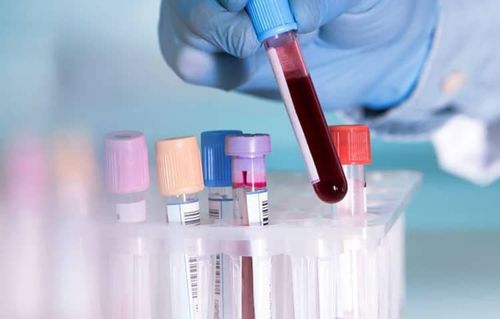
Các xét nghiệm máu được lặp lại thường xuyên trong nhiều ngày cho phép nhân viên y tế tìm kiếm tế bào bạch cầu đang chống lại bệnh tật và những thay đổi bất thường trong ADN của các tế bào máu
6. Treatment
The treatment goals for acute radiation sickness are to prevent radioactive contamination from spreading; treat life-threatening injuries such as burns and trauma; relieve symptoms and control pain.Decontamination Decontamination involves removing external radioactive particles by removing clothing and shoes which removes about 90% of contamination. Gently wash with soap and water to remove radioactive particles from the surface of the skin.
Decontamination works to prevent radioactive materials from spreading further and reduces the risk of internal contamination by inhalation, ingestion or open wound.
Treatment of damaged bone marrow Patients will be given a protein called granulocyte colony-stimulating factor to promote the growth of white blood cells that fight the effects of the disease. of radiculopathy to bone marrow. Also, medications used to treat it include filgrastim (Neupogen), sargramostim (Leukine), and pegfilgrastim (Neulasta) to increase white blood cell production and help prevent possible infections. If the body has severe damage to the bone marrow, the person may also receive a transfusion of red blood cells or platelets.
Treatment of internal radiation Some treatments can reduce damage to internal organs caused by particle radiation. Healthcare workers will only use these treatments if it is certain that a person has been exposed to a particular type of radiation. These treatments include:
Potassium iodide (ThyroShield, Iosat), which is an inactive form of iodine. Iodine is essential for the normal functioning of the thyroid gland. If the body is exposed to a lot of this radiation, the thyroid gland absorbs the radioactive iodine (Radioactive iodine) like other forms of iodine and the radioiodines are eventually eliminated from the body in the urine. If potassium iodide is taken, it can fill the "gap" in the thyroid gland and block the absorption of radioactive iodine. Potassium iodide is not a cure and is most effective if taken within a day of exposure to radioactive iodine (Radioactive iodine) Prussian blue (Radiogardase) is a dye that has the ability to bind bound with particles of radioactive elements such as cesium and thallium. The radioactive particles are then excreted in the feces. This treatment speeds up the removal of radioactive particles and reduces the amount of radioactivity that cells can absorb Diethylenetriamine pentaacetic acid (DTPA). DTPA binds to particles of the radioactive elements plutonium, americium and curium. These radioactive particles are then excreted in the urine by the body, thereby reducing the amount of radiation absorbed. Supportive treatment Besides the main treatment above, the patient will need additional supportive treatment to treat other problems caused by radiation exposure such as:
Infection Headache Fever Diarrhea Nausea and vomiting Loss Water Burns. Hospice Care For patients who have received very large amounts of radiation, there is little chance of recovery. Depending on the severity of the disease, the person can die within two days or two weeks. Therefore, for these cases, the patient will be given medication to control pain, nausea, vomiting and diarrhea, and psychological care.
Please dial HOTLINE for more information or register for an appointment HERE. Download MyVinmec app to make appointments faster and to manage your bookings easily.
Reference source: Mayoclinic.org



